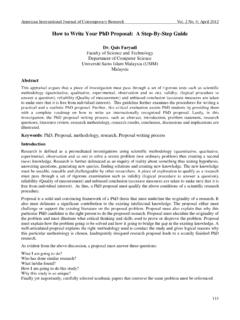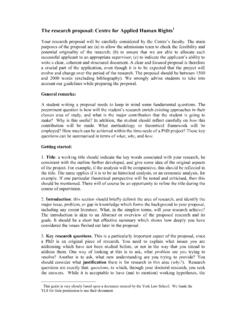Transcription of THESIS PROPOSAL - AU
1 THESIS PROPOSAL . MODERNIZATION AT ORGANIZATIONAL FIELD LEVEL: REPLACING MANUAL WORK PROCEDURES. WITH INFORMATION SYSTEMS. Committee: Charlotte J. Brandt Supervisor: Andrea Carugati J rn Flohr Nielsen September 2012 Tina Blegind Jensen THESIS PROPOSAL Charlotte J. Brandt Contents Preface .. 3. 4. 1 Research topic, theory, and research question .. 5. Practical 6. Theoretical relevance .. 7. Research question .. 8. 2 Research design .. 8. Reflections on philosophy of science .. 8. Validity Network Schema .. 9. 3 Method .. 10. Initiation of the research .. 10. Initial data collection .. 11. Analyzing and collecting more data .. 11. 4 Theoretical lens .. 12. 5 Research plan .. 13. Conferences .. 13. Change of environment.
2 13. Course plan .. 13. References .. 15. Appendix .. 17. A. Article abstracts .. 18. B. Teaching activities .. 19. 2. THESIS PROPOSAL Charlotte J. Brandt Preface This THESIS PROPOSAL is an outline of my THESIS describing the research to be conducted over the next 3 years. The target audience is the appointed committee, the supervisor, and interested colleagues. The purpose of presenting this THESIS PROPOSAL is to get feedback on the work I have produced so far and to discuss the research plan, is the identified modernizer/modernizee-pattern relevant. I hope for an open-minded audience providing rich feed-back. I would like to thank Toke Bjerregaard, Per Svejvig and my supervisor Andrea Carugati for their wise advises and insightful comments to earlier versions of this THESIS PROPOSAL , and Vibeke Frisenvang for the close reading and very useful language revision.
3 Charlotte J. Brandt Silkeborg, August 2012. 3. THESIS PROPOSAL Charlotte J. Brandt Summary The area of concern of this project is the dynamics of change at the organizational field level. The project will be researching change initiatives from one organization (modernizer) aiming to modernize many . typically minor organizations (modernizees) by replacing manual work processes with information systems (IS). The current global economic crisis forces organizations around the world to make the most of their daily operations. Recent studies in different industries show that a rise in long-term organizational efficiency can be expected when adopting information systems to support the daily operations as well as administration.
4 Hence adopting IS is a means to prosper or simply to stay in business, and a strong motivation for the individual modernizee organization to modernize could be anticipated. But, despite the consequences of NOT modernizing, the decision is often influenced by entrenched habits and feelings towards status quo. The modernization attempt can produce unexpected outcomes and modernizing through ICT is a process not yet adequately studied. In studies of modernization attempts focus has primarily been on the organization taking the initiative to the change, the modernizer. The purpose of this study is to analyze how an organization, the modernizee, decides to react to a change initiative from another organization. By shifting focus to the modernizees, this study aims to contribute to the existing theory and knowledge with a more balanced view on the process of modernization through ICT.
5 The research question of this study is: How does an organizational field modernize by replacing manual work procedures with information systems? This is a theory-building, exploratory research project as the aim of this study is to understand and explain rather than identify causal patterns and regularities. 4. THESIS PROPOSAL Charlotte J. Brandt 1 Research topic, theory, and research question The area of concern of this project is the dynamics of change at the organizational field level. The project will be researching change initiatives from one organization (modernizer) aiming to modernize many . typically minor organizations (modernizees) by replacing manual work processes with information systems (IS).
6 Modernization is defined in The Oxford English Dictionary as ; to change (obsolete spelling, words, or language) for modern equivalents; and used here in the sense of an on-going, evolutionary process performed by organizations in order to survive and prosper. Modernization implies a change, departing a present state for a future, better state; in this case the present state is manual work processes that are to be replaced with information systems. According to Currie & Guah (2007) the organizational field as a useful framework for identifying relevant actors and phenomena of interest. As I am interested in organizations which does not necessarily compete or maintain a network among themselves, but merely interact through a common modernizer, such as a central government or actor in the supply chain DiMaggio & Powel's (1983) definition of an organizational field comprising those organizations that, in the aggregate, constitute a recognized area of institutional life: key suppliers, resource and product consumers, regulatory agencies, and other organizations that produce similar services or products will be used here.
7 This study aims to provide an understanding of the complexity of the modernization of an organizational field by describing and analyzing the modernization process by which the individual organizations change. The majority of the literature on how to manage change when introducing new information systems has focused on intra-organizational subjects, primarily on how an organization motivates its employees to adapt to changes (Benjamin & Levinson, 1993; Lamb & Kling, 2003; Orlikowski & Gash, 1994). Regarding these changes, the balance of power is skewed because the initiator of the change holds some sort of control over the ones who have to perform the change through an employment agreement. There are, however, only a few studies on how an organizational field, not under direct control of the initiator, reacts to an introduction of a new information system.
8 Examples of such changes include how milk suppliers react to an initiative from a co-operative dairy, introducing a new production control system; how the local municipalities react to an initiative from the central government to adapt to a joint public IT. architecture; how hospitals react to the health ministry, implementing a nationwide electronic patient record. These few studies depict either less complex stories of strategic power of the buyer (Stalk, Evans, &. Shulman, 1992) or complex stories where change is seldom accepted as planned. With the aim to explore dynamics of change at the organizational field level this study is placed along these inter-organizational studies. Traditionally the adoption of information systems has been described as a sequence of a varying number of phases.
9 To name a few, Thong (1999) identifies three phases; initiation, adoption, and implementation, and Gallivan (2001) identifies six phases; initiation, adoption, adaptation, acceptance, routinization, and infusion. These adoption sequences form a general pattern which is depicted in Figure 1 The traditional understanding of IS adoption. IS adoption initiates with the decision process in which information about the technology at hand is gathered and evaluated. If the organization decides to stay unchanged, the 5. THESIS PROPOSAL Charlotte J. Brandt modernization process is discontinued and the organization remains in the current state. If modernization is chosen, technical as well as organizational implementation of the functionality in the business must follow to ensure the expected effect.
10 If the implementation fails, the modernization process is discontinued and the organization remains in the current state. If on the other hand the technical implementation completes successfully, the organization must adopt the functionality as their new daily routines to ensure the expected effect. If the adoption fails, the modernization process is discontinued and the organization remains in the current state. Failure in any of the three phases will result in the manual work processes remaining status quo and the modernization effect will fail to appear. So, in order to reach the future state, the organization must complete the three phases with a successful outcome. Figure 1 The traditional understanding of IS adoption, based on Thong (1999) and Gallivan (2001).





